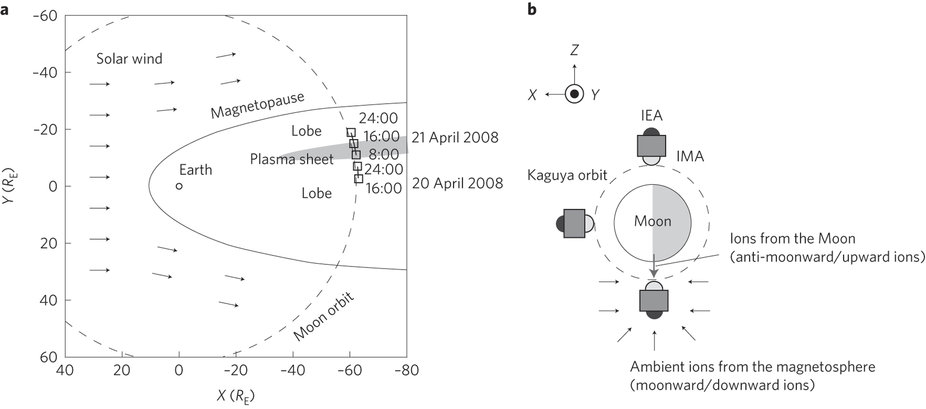Research Abstract
磁気圏の風によって月まで運ばれた生命活動由来の地球の酸素
Biogenic oxygen from Earth transported to the Moon by a wind of magnetospheric ions
2017年1月30日 Nature Astronomy 1 : 26 doi: 10.1038/s41550-016-0026

月は、その軌道上で5日間は地球の磁気圏によって太陽風の爆撃から遮蔽されており、この磁気圏は地表からのイオンで満たされている。地表の窒素と希ガスが月の土中に存在する可能性は、それらの同位体組成に基づいて議論されてきたが、月の金属における酸素同位体の複雑な分別(とくに16 Oに乏しい成分の起源)は依然として謎である。本論文では、日本の探査機かぐやの観測により、月が地球のプラズマ・シート内に位置していたときにだけ、1~10 keVのO+ イオンが際立って多く見られたことについて報告する。そのようなエネルギーをもつO+ イオンの金属への侵入深さと、地球の上層大気の16 Oに乏しい質量非依存の分別とを考慮すると、生命活動によって生じた地表の酸素は、地球風(少なくとも 2.6× 10 4 ions cm-2 s-1)によって月まで運ばれており、月の表土の表面からおよそ数十ナノメートルの深さまで注入されていると結論づけられる。我々は、数十億年前の地球大気が現在の月の表面に保存されているという可能性を示唆する。
Corresponding Author
For five days of each lunar orbit, the Moon is shielded from solar wind bombardment by the Earth’s magnetosphere, which is filled with terrestrial ions. Although the possibility of the presence of terrestrial nitrogen and noble gases in lunar soil has been discussed based on their isotopic composition, complicated oxygen isotope fractionation in lunar metal (particularly the provenance of a 16O-poor component) remains an enigma. Here, we report observations from the Japanese spacecraft Kaguya of significant numbers of 1–10 keV O+ ions, seen only when the Moon was in the Earth’s plasma sheet. Considering the penetration depth into metal of O+ ions with such energy, and the 16O-poor mass-independent fractionation of the Earth’s upper atmosphere, we conclude that biogenic terrestrial oxygen has been transported to the Moon by the Earth wind (at least 2.6 × 104 ions cm−2 s−1) and implanted into the surface of the lunar regolith, at around tens of nanometres in depth. We suggest the possibility that the Earth’s atmosphere of billions of years ago may be preserved on the present-day lunar surface.

